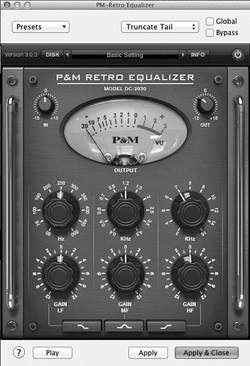 The Retro Equalizer is a simple three-band EQ. Each band has a gain and frequency knob, and the high and low bands can be set to either Shelving or Bandpass mode, while the center band can be switched between Bandpass mode and the (much steeper) Notch mode. Also here are In and Out gain controls that go from -18dB and +18dB. While this module sounds very good, the frequency and gain knobs are all stepped rather than continuous, which makes it a bit less useful. So if you need more control, you’ll have to try the...
The Retro Equalizer is a simple three-band EQ. Each band has a gain and frequency knob, and the high and low bands can be set to either Shelving or Bandpass mode, while the center band can be switched between Bandpass mode and the (much steeper) Notch mode. Also here are In and Out gain controls that go from -18dB and +18dB. While this module sounds very good, the frequency and gain knobs are all stepped rather than continuous, which makes it a bit less useful. So if you need more control, you’ll have to try the...
...Liquid Air-Q equalizer. This one comes with a low-band filter that handles from 40 Hz to 150 Hz, then two fixed-frequency filters at 830 Hz and 2.2 kHz, and finally a high-frequency shelf that goes from about 2 kHz up to 18 kHz (really? I guess that’s why they call it “Air”). On the surface the Liquid Air-Q seems less flexible than the other, more conventional EQs, but in practice I found it most useful for cleaning up and punching up VO tracks. The low band took care of rumble, while the low-mid band seemed just about right for decreasing any “boxy” qualities. The “air” business does indeed increase intelligibility, but like all EQ tools it can be used for good or for evil, and a little goes a very long way. I like this one a lot, despite its specialized settings.
OTHER FAVES
Both the Digital Reverb and the Digital Plate reverb are very good-sounding units which I’d definitely use (if I didn’t already have too many of them). The Ambiosoniq graphic EQ is a serviceable graphic EQ with a twist -- cranking the Amb-Soniq knob messes with the phase of a stereo track to “spread” the imaging, which is useful in some situations for SFX and lame music tracks. The Ultramaxit Limiter is not nearly as flexible as the Retro Limiter, but it what you need is a seriously limited track, you’ll definitely get it with this plug-in.
Finally, although I’m not sure where I could use it, I’d love to find a place to use it, just because the Dimension 3D is the best emulation I’ve heard so far of a Roland Dimension D chorus unit (which I’m still sick about selling years ago). It’s rich and lush and diffuse and I love it but can’t justify putting on that nice lady’s voice over track even though I really want to just because it makes everything sound So Very Cool.
I’LL BE HAVING A FEW OF THESE, PLEASE
The documentation is somewhat thin and, as mentioned, in some cases it’s flat-out incorrect. But it will give you a sense of what that oddly-labeled knob in the middle of the plug is designed to do, anyway. But the best way to learn how to use these plugs is to simply insert one and begin twiddling. The user interfaces on each are consistent between the different plugs, so it’s likely that you won’t hurt yourself (or your ears) as you experiment.
Besides, it’s a nice way to while away a Saturday afternoon, when I should be doing something else that I’d rather not do. Steve sez check them out.
The P&M plug-ins are available for purchase from the Don’tCrac[k] site at store.dontcrack.com at $49 each, or in bundles -- see the site for more information on those. More information about the plug-ins is available at www.plugandmix.com.
♦

